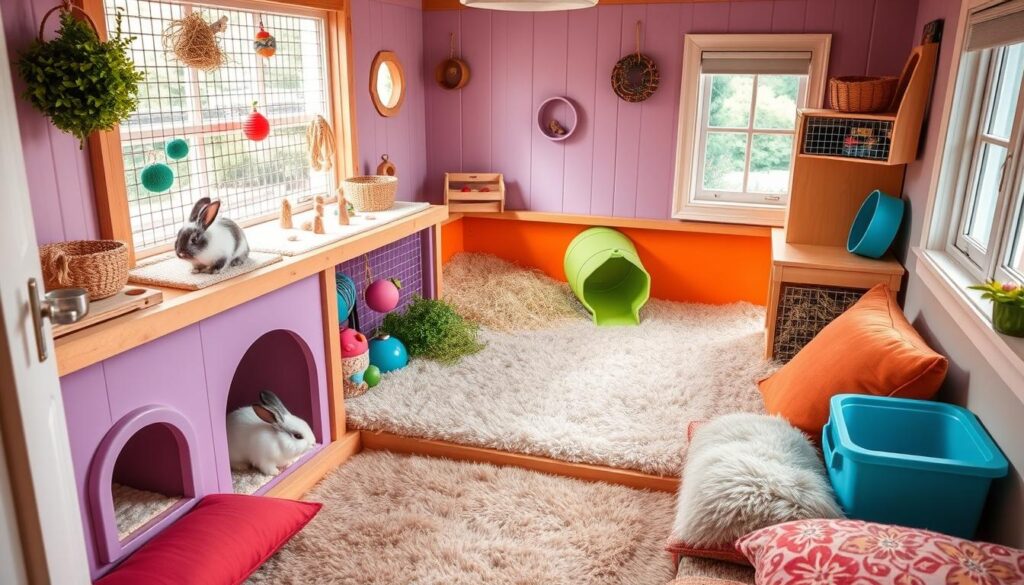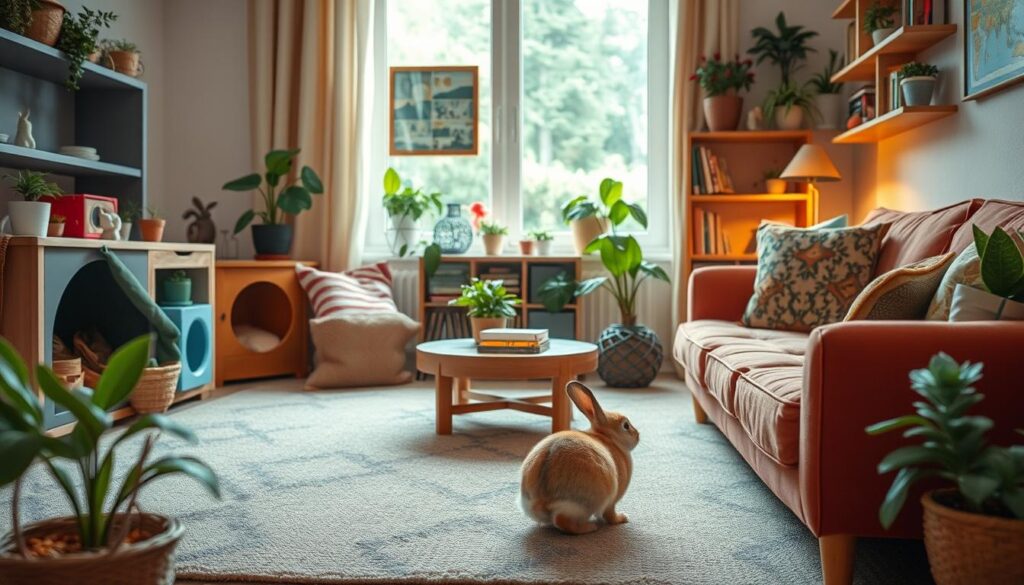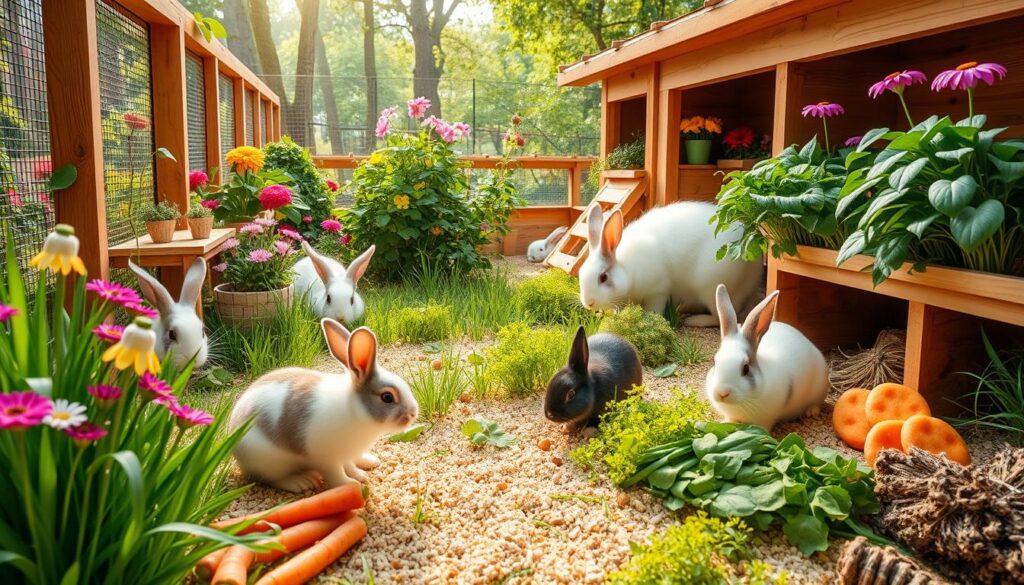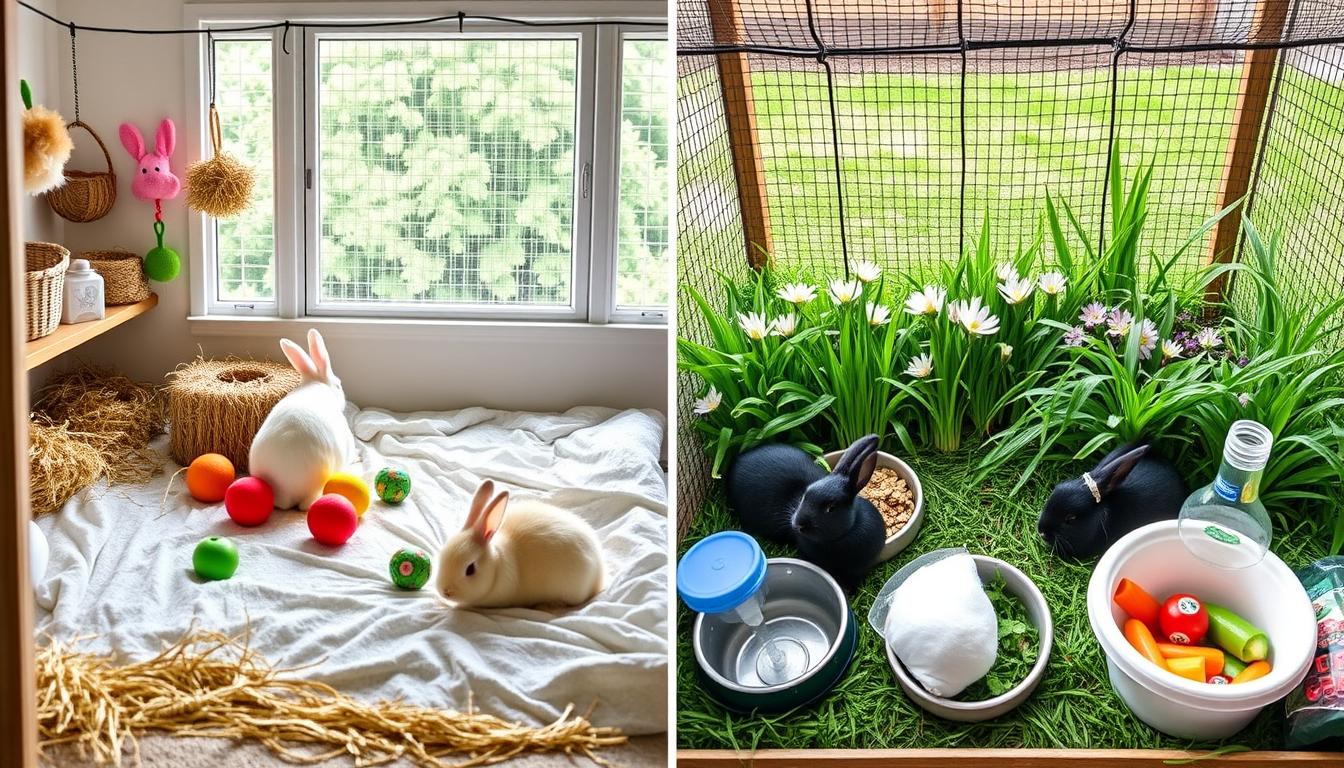Rabbit care is key to a happy, healthy life for your pet. Knowing the basics of diet, housing, and health checks is crucial. It’s important to create a nurturing space that meets your rabbit’s needs.
Proper rabbit care needs attention and a commitment to your pet’s well-being. By following important tips, you can ensure a safe, healthy home for your rabbit. This includes a good diet, regular health checks, and a comfy living space.
Introduction to Rabbit Care
Caring for a rabbit is a rewarding task that requires dedication. Understanding your rabbit’s needs and providing proper care helps build a strong bond. It ensures a happy, healthy life for your pet.
Key Takeaways
- Provide a balanced diet that meets your rabbit’s nutritional needs
- Create a safe and comfortable living space that meets your rabbit’s physical and emotional needs
- Regular health checks are essential for maintaining your rabbit’s health and well-being
- Rabbit care and maintenance requires attention to detail and a commitment to providing the best possible life for your pet
- Pet rabbit care involves creating a nurturing environment that meets your rabbit’s physical and emotional needs
- Effective rabbit care and maintenance involves a combination of proper diet, regular health checks, and a comfortable living space
Getting Started with Rabbit Care and Maintenance
Bringing a new rabbit home means understanding their basic needs. This ensures they live happily and healthily. Grooming tips and indoor care are key. A balanced diet, fresh water, and a clean space are just the start.
Setting up a good environment is crucial for indoor rabbit care. Choose the right cage size and bedding. Keep the temperature comfortable. This creates a safe, cozy space for your rabbit to grow.
Understanding Your Rabbit’s Basic Needs
Rabbits need regular grooming to stay healthy. Brushing their fur prevents matting and tangling. Hiding places and toys also help reduce stress and encourage exercise.
Initial Setup Essentials
When setting up your rabbit’s home, remember these essentials:
- Food and water bowls
- A water bottle or dispenser
- A hiding place or two
- Toys and chew items
These items make your rabbit feel secure and comfortable in their new home.
First-Week Care Guidelines
In the first week, establish a routine and watch your rabbit’s health. Look for signs of illness or stress. Provide fresh water and a balanced diet. Follow these tips to help your rabbit settle and thrive.
Creating the Perfect Living Space for Your Rabbit
Creating a perfect living space for your rabbit is key. Outdoor access is crucial for their health. Regular outdoor rabbit hutch maintenance keeps their home clean and healthy.
A rabbit health check-up is vital to prevent health issues. Watch for changes in behavior, appetite, and stool quality. This helps keep your rabbit happy and healthy.
- Make sure there’s enough room for them to move and exercise.
- Ensure good ventilation and temperature control.
- Provide toys and activities to keep them stimulated.
- Create a cozy spot for them to rest and relax.
Follow these tips to create a space that meets your rabbit’s needs. This way, you’ll give them a happy and healthy home.
Indoor Rabbit Housing Solutions
Keeping your rabbit safe and comfy is key for its health. Indoor rabbit homes are a great choice. A good rabbit diet and nutrition plan is vital. But, don’t forget about rabbit housing essentials like cage size, bedding, and keeping the right temperature.
Choosing the right indoor rabbit home involves several important factors. Here are a few key things to remember:
- Cage size: The cage should be big enough for your rabbit to stand up, turn around, and move around comfortably.
- Bedding options: You can choose from wood shavings, hay, and recycled paper for bedding.
- Temperature control: Rabbits don’t like extreme temperatures, so keeping their space comfy is crucial.

Cage Size Requirements
The cage size depends on your rabbit’s size and breed. A cage of at least 2×4 feet is usually recommended.
Bedding Options
There are many bedding choices, each with its own pros and cons. It’s important to pick one that’s safe, comfy, and easy to clean.
Temperature Control Tips
Rabbits don’t like extreme temperatures. To keep them comfy, place their cage in a room with a steady temperature. Use a thermometer to check the temperature and make sure there’s good air flow.
Outdoor Hutch Setup and Management
Keeping your rabbit safe and healthy is key. Setting up a good outdoor hutch is important. It needs to be safe and fun for your rabbit. Also, regular health checks are crucial to avoid sickness and keep your rabbit happy.
When setting up an outdoor hutch, think about protection from the elements and predators. A hutch that’s well-ventilated and dry helps prevent breathing problems. It also keeps your rabbit healthy. Plus, giving your rabbit regular exercise and fun activities helps prevent boredom and stress.
Some important things to think about for outdoor hutch setup and management include:
- Providing a large enough enclosure to allow for exercise and movement
- Ensuring adequate ventilation and protection from the elements
- Offering a balanced diet and access to fresh water
- Regularly cleaning and maintaining the hutch to prevent health issues
By following these tips and focusing on your rabbit’s health and exercise, you can make a happy home for them. Always watch your rabbit’s behavior and change their environment if needed. This ensures they stay happy and healthy.
Daily Rabbit Care Routines
Keeping your pet rabbit happy and healthy needs a daily care routine. Rabbit care and maintenance means setting up a schedule. This ensures your rabbit gets the care it needs. For more tips, check out rabbit care websites.
Tasks like feeding, exercise, and cleaning are part of the daily routine. Pet rabbit care also means watching your rabbit’s health and behavior. Adjust the routine as needed. A weekly deep clean is key to a clean living space.
Morning Care Checklist
- Feed your rabbit a balanced diet
- Provide fresh water
- Clean the cage and remove soiled bedding
Evening Maintenance Tasks
- Clean the food and water dishes
- Check the cage for any damage or escape routes
- Provide mental stimulation and exercise
Nutrition and Feeding Guidelines
It’s key to give your rabbit a balanced rabbit diet and nutrition. A good diet includes pellets, hay, and fresh veggies. Choose high-quality pellets that are high in fiber and low in protein. Also, give lots of hay, like timothy hay, to keep their teeth healthy.
Adding fresh veggies slowly is important to avoid upset stomachs. Safe veggies are leafy greens, carrots, and bell peppers. Fresh fruits like berries and apples can be treats, but in small amounts. Make sure your rabbit always has fresh water.

Good rabbit housing essentials mean more than just a safe place to live. It’s about creating a space that encourages healthy eating. A rabbit’s cage should be easy to get to food and water. It should also have enough room for them to move and exercise.
Here are some tips for a healthy rabbit diet:
- Provide a variety of foods, including pellets, hay, and fresh vegetables
- Choose high-quality pellets that are rich in fiber and low in protein
- Introduce fresh vegetables gradually to prevent digestive upset
- Ensure access to fresh water at all times
Essential Grooming Practices
Regular grooming is key for your rabbit’s health and happiness. It’s part of indoor rabbit care. Grooming stops problems like matting, tangling, and hairballs. With the right rabbit grooming tips, your rabbit will stay clean, happy, and healthy.
First, you need the right tools. This includes brushes, nail clippers, and dental care stuff. Here are some important grooming steps:
- Brushing: Use a soft-bristled brush or a slicker brush to remove loose hair and prevent matting.
- Nail trimming: Trim your rabbit’s nails regularly to prevent overgrowth and cracking.
- Dental care: Check your rabbit’s teeth regularly for signs of wear or decay, and provide plenty of hay and chew toys to keep them healthy.
By following these rabbit grooming tips and adding them to your indoor rabbit care routine, your rabbit will be happy and healthy. Always be gentle and patient when grooming. If you’re unsure, get professional help.
Exercise and Enrichment Activities
Keeping your rabbit healthy and happy is key. They need regular exercise and mental challenges. This helps prevent obesity, boredom, and stress. A mix of physical and mental activities keeps them joyful and well.
To ensure your rabbit gets enough exercise, try these ideas:
- Food puzzle toys to challenge and engage your rabbit
- Tunnels and tents for hiding and playing
- Cardboard boxes for climbing and exploring
Exercise and playtime are vital for your rabbit’s health. A stimulating environment encourages them to stay active and mentally sharp. Offering various toys and activities keeps your rabbit happy and healthy.
Rabbits are intelligent and social animals that require regular exercise and mental stimulation to thrive. By providing a stimulating environment and meeting your rabbit’s exercise needs, you can help create a happy and healthy life for your pet.
Health Monitoring and Preventive Care
Regular rabbit health check-up is key for your rabbit’s health. Daily, watch your rabbit’s behavior, appetite, and physical state. This early detection helps get vet care quickly.
A rabbit health check-up looks for illness signs like runny eyes or sneezing. Also, check their living area for cleanliness and safety. These steps in rabbit care and maintenance prevent health problems and keep your rabbit well.
Rabbits can face issues like respiratory problems or dental issues. Knowing these risks and taking steps like a balanced diet helps. Regular rabbit health check-up and rabbit care and maintenance are vital for your rabbit’s health.
Warning Signs to Watch For
- Changes in appetite or water intake
- Weight loss or gain
- Changes in stool or urine output
- Runny eyes or sneezing
Being proactive with your rabbit’s health can prevent many issues. Always talk to a vet if you’re worried about your rabbit’s health.
Seasonal Care Adjustments
As a responsible pet owner, it’s key to think about the changing seasons for rabbit care and maintenance. Keeping your pet comfortable is vital for their health and happiness. The seasons bring changes in temperature, humidity, and daylight, affecting your rabbit’s mood and health.
To keep your pet healthy, you’ll need to adjust their pet rabbit care routine. This might mean adding warmth in cold months or keeping them cool in hot ones. Use fans or air conditioning to keep the temperature right, and make sure their space has good air flow.
- Watch temperature changes and adjust their space as needed
- Give them extra bedding or insulation in cold months
- Make sure they always have fresh water
By making these seasonal care changes, you can avoid health problems from extreme temperatures. Always put your rabbit’s comfort first, and talk to a vet if you’re worried about their health.
Rabbits are sensitive to temperature extremes, so it’s crucial to provide a comfortable environment to prevent heatstroke or hypothermia.
Bonding and Social Needs
Rabbits love to interact and need friends. They also need to stay active for their health. Knowing these needs helps you make your rabbit happy and healthy.
To introduce rabbits, start with scents and sounds first. Then, let them meet under your watch, rewarding calm behavior. This way, they can get along without fights.
It’s important to spend time with your rabbit too. Play, groom, and cuddle them. This strengthens your bond and makes your rabbit happy.
Here are some tips for being good with your rabbit:
- Move slowly and calmly around your rabbit to avoid startling them
- Offer a variety of toys and activities to keep your rabbit engaged and stimulated
- Provide a safe and comfortable environment for your rabbit to relax and feel secure
By following these tips, you can have a strong and loving bond with your rabbit. This ensures a happy and healthy life for both of you.
Rabbit-Proofing Your Home
Creating a safe space is key for your rabbit’s health. Rabbit-proofing your home is vital to prevent accidents. It helps keep your rabbit safe and healthy.
First, block off risky areas like electrical outlets and toxic substances. Secure wires and remove harmful materials. These steps protect your rabbit from accidents and health issues.

- Electrical outlets and wires
- Toxic substances, such as cleaning supplies and pesticides
- Fragile items, such as vases and glassware
- Small spaces, such as behind furniture and appliances
Securing your home makes a safe space for your rabbit. This helps them thrive in a healthy environment.
Indoor rabbit care is more than just safety. It’s about your rabbit’s health and happiness. Rabbit-proofing your home ensures a long, happy life for your rabbit.
Emergency Care Preparedness
Being a responsible pet owner means being ready for emergencies. This includes having a first aid kit and knowing when to call a vet. Being prepared helps prevent health issues and ensures your rabbit gets the best care.
Emergency care is key for pet rabbit care. Having a plan for emergencies like power outages is important. This keeps your rabbit safe and healthy.
First Aid Essentials
- Bandages and gauze
- Antibiotic ointment
- Thermometer
When to Contact a Vet
If you see signs of illness or injury, like trouble breathing or loss of appetite, call a vet right away. Being proactive and getting medical help when needed is crucial. It ensures your rabbit stays happy and healthy.
Travel and Vacation Care Planning
When planning a trip, it’s key to think about rabbit care and maintenance for your pet’s health. You can use a pet-sitting service for professional care or board your rabbit at a facility that focuses on rabbit health.
When picking a boarding place or pet-sitter, consider these points:
- Experience with rabbits and their needs
- Availability of vet care for emergencies
- Clean, comfy living areas for your rabbit
Get your rabbit used to their carrier and give them lots of exercise and mental games before you leave. This can lower stress and prevent travel-related rabbit health problems.
By planning and preparing for your trip, you can keep your rabbit happy and healthy, even when you’re not there.
Rabbits are social animals and need attention and care, even when their owners are away. With proper planning and preparation, you can ensure your rabbit’s needs are met and they stay healthy and happy.
Long-Term Care Success: Building a Happy Life for Your Rabbit
Long-term rabbit care and maintenance is key to a happy, healthy life for your pet rabbit. As your rabbit gets older, regular exercise and mental play are vital. A big living space and chances to socialize are also crucial for their happiness.
For more info on pet rabbit care, learning about your rabbit’s needs is important. This includes a balanced diet, regular health checks, and a safe, fun environment. Following these tips can help your rabbit live a long, joyful life.
Some important things to consider for long-term rabbit care and maintenance are:
- Regular exercise and playtime
- A comfy, safe living space
- Regular health checks and care
- A nutritious, balanced diet

By focusing on your rabbit’s needs and providing long-term care, you can create a happy, healthy life for them. Always keep up with the latest rabbit care and maintenance advice to give your rabbit the best care.
Embracing the Journey of Rabbit Companionship
Starting your journey with a rabbit is incredibly rewarding. It’s filled with joys and challenges. You’ll form a special bond with your rabbit, which is essential.
Rabbits are social animals that love interaction and affection. By building a strong relationship, you’ll keep them happy and healthy. Plus, it will make your life better too.
Looking after your rabbit is a big job, but it’s worth it. You’ll see their playful side and enjoy their calm company. Remember, your rabbit needs your time for play and to show their natural behaviors.
As you keep caring for your rabbit, be proud of your love and effort. Celebrate the good times and learn from the tough ones. With patience and a focus on your rabbit’s needs, you’ll have a strong bond for many years.
FAQ
What are the essential tips for rabbit care and maintenance?
To care for your rabbit, first understand their basic needs. Set up a great living space. Provide a balanced diet and ensure they get enough exercise and enrichment.
Keep an eye on their health and make seasonal care changes as needed.
How do I set up the perfect living space for my rabbit?
For a perfect space, consider the cage size and bedding. Keep the temperature right and make sure there’s enough room for your rabbit to move and explore.
Both indoor and outdoor hutch setups have their own needs.
What are the key elements of a rabbit’s balanced diet?
A rabbit’s diet should mainly be hay, fresh water, and veggies. Rabbit pellets are okay in small amounts. Know what they need and avoid harmful foods.
How do I properly groom my rabbit?
Grooming includes brushing, nail trimming, and dental care. Use the right brush and groom regularly. This keeps their coat and nails healthy.
What kind of exercise and enrichment activities does a rabbit need?
Rabbits need exercise and mental stimulation. Provide toys, tunnels, and safe play areas. Make sure they have enough space to run and explore.
How do I monitor my rabbit’s health and prevent common issues?
Check for health issues like overgrown teeth and digestive problems. Keep up with vaccinations and address any signs of illness quickly. This helps keep your rabbit healthy.
How do I properly introduce my rabbit to other rabbits or humans?
Introduce your rabbit slowly and under supervision. Let them get used to each other. This makes interactions safe and stress-free for your rabbit.
How do I rabbit-proof my home to keep my rabbit safe?
Block off dangerous areas and secure wires. Remove toxic plants and create a safe space for your rabbit to explore.
How do I prepare for emergencies and provide first aid for my rabbit?
Have a first aid kit ready and know the signs of illness or injury. Learn basic first aid to respond quickly in emergencies.
How do I plan for my rabbit’s care during travel or vacation?
Consider boarding, pet-sitting, or traveling with your rabbit in a suitable crate. Make sure they’re comfortable and safe when you’re away.

